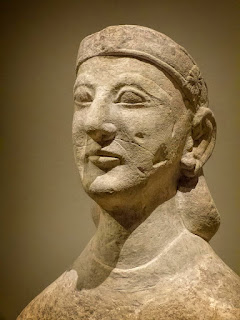During the Middle Assyrian Period, the social position of women in Assyria became lower than that of neighboring societies. Men were permitted to divorce their wives with no compensation paid to the latter. If a woman committed adultery, she could be beaten, have her ears or nose cut off, her nipples torn off, her eyes gouged out, or put to death. It's not certain if these laws were seriously enforced, but they appear to be a backlash against some older documents that granted things like equal compensation to both partners in divorce.
A law code dating from the reign of King Tiglathpileser I (1115 - 1076 BCE), a particularly misogynistic ruler, in which punishments were especially severe, especially for women, reveals a woman could be punished not only for their individual transgressions, but also for crimes committed by their relatives under the principle of ius talionis (an eye for an eye).
‘If a man forcibly seizes and rapes a maiden who is residing in her father’s house... the father of the maiden shall take the wife of the rapist of the maiden and give her over to be raped. He shall not return her to her husband, he shall take her (for himself).'
'If a woman has procured a miscarriage by her own act, when they have prosecuted her and convicted her, they shall impale her on stakes without burying her. If she died in having the miscarriage, they shall impale her on stakes without burying her.’
`If a woman has crushed a gentleman’s testicle in a brawl, they shall cut off one finger of hers. If the other testicle has become affected along with it by catching the infection, even though a physician has bound it up, or she has crushed the other testicle in a brawl, they shall tear out both her eyes.’
The women of the king's harem and their servants were also subject to harsh punishments, such as beatings, mutilation, and death. Scholars have pointed out that this suppression of women's rights appears to have corresponded to the rise of monotheism in Assyrian theology. As the Assyrians conquered more and more peoples and elevated their god, Ashur, from a local god to supreme god over all and far removed from the natural world, women, with their critical role in the natural world as life bearer, became diminished. A man who saw a woman behaving in any way deemed unacceptable had to report that woman to the authorities instantly or risk 50 lashes, mutilation, and enslavement for a month.
However, during the Neo-Assyrian Period (883-608 BCE) royal women, at least, became independently wealthy and could buy land based on letters that have been recovered. There are records of female officials who had important roles running the households of royal ladies and possibly others as well. Women outside the royal household also worked as priestesses and prophetesses. But, no evidence of temple prostitution has been discovered and is thought to have been merely invented by later Greek authors to illustrate the moral decline of Babylon.
The Assyrian word harimtu, which was once translated as prostitute is now thought to refer to just a single woman without a husband or father and not tied to an institution. Although the term was used derogatorily in several texts as an insult, it was not defined as such universally.
The status of women in Assyria probably differed little from women throughout the patriarchal societies of the ancient Near East. The brutality used to enforce the social order was the exception.
Assyria, in general, had much harsher laws than most of the region. Executions were not uncommon, nor were whippings followed by forced labor. Some offenses allowed the accused a trial under torture or duress. One tablet that covers property rights has brutal penalties for violators. A creditor could force debtors to work for him, but not sell them. Sex crimes were punished identically whether they were homosexual or heterosexual. An individual faced no punishment for penetrating a cult prostitute, someone of an equal or lower social class, such as slaves, or someone whose gender roles were not considered solidly masculine. Such sexual relations were even seen as good fortune. However, homosexual relationships with royal attendants, between soldiers, or with those where a social better was submissive or penetrated were either treated as rape or seen as bad omens, and punishments applied.
Read more about women in ancient Assyria at:
https://lb.boell.org/en/2017/02/09/women-fundamentalism-and-terror-echoes-ancient-assyria
and more about Tiglath Pileser I at:
https://www.ancient.eu/Tiglath_Pileser_I/
Image: Head of a female figure ca. 8th–7th century B.C.E. Assyrian at the Metropolitan Museum of Art courtesy of the museum.
This female head, carved in the round, was found in the Burnt Palace at Nimrud and may have originally been part of a composite statuette made of various materials and overlaid with gold foil. A square mortise cut into the bottom of this piece suggests that a tenon would have secured it to a now lost body. Part of the head has been damaged, but several features that remain, including the large, originally inlaid eyes, prominent ears, hooked nose, small mouth, and receding chin, are characteristic of North Syrian ivories. The hair falls in long individual locks, crowned by a diadem of rosettes and inlaid discs (the original colored glass or semiprecious stone inlays are now lost) tied at the back of the head. - Metropolitan Museum of Art, New York.






















































